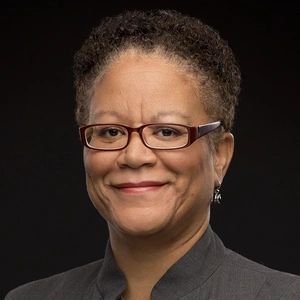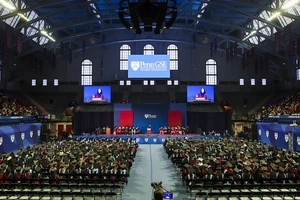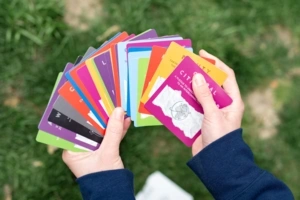Faculty Expert
Marsha Richardson, right, leads a discussion at Penn GSE in 2019.
We are at the beginning of a new wave in education, where teachers, counselors, and school support staff understand the need to help address student’s emotional needs.
But as they take care of their students, educators must also consider how they are impacted by traumatic events and care for themselves. That was the message Penn GSE clinical psychologists Marsha Richardson delivered during her EDTECH Week Masterclass.
Richardson, who teaches in Penn GSE’s school counseling programs, originally designed her Masterclass to think through ways to support students and educators during the Covid-19 pandemic. But she spoke as protestors marched in cities across the country to decry systemic racism and police brutality.
Noting that we are experiencing two public health crises, Richardson spoke about the need to acknowledge the lack of safety, connection, and stress that everyone is experiencing.
Richardson described the situation after the death of George Floyd at the hands of Minneapolis Police as one of collective disturbance in which all parties involved have been hurt by what is happening around them. “This disturbance usually occurs when people have negative thoughts and feelings towards those in power,” she said.
“Here ...we have a Black man whose death was videotaped. His death was at the hands of ...a person who was supposed to protect and serve. So the collective disturbance is...the tip of the iceberg, from a historical perspective, that has manifested into what we're seeing now.”
“So the collective disturbance...is a systemic and organizational dynamic ...where everyone is reacting and responding to the stressors to the trauma in their own unique ways.”
Within a school setting, “students don't have a platform or the ability...to express their feelings and their experiences, staff or school personnel are managing crises...as if their hair is on fire, and then collectively there's a loss of hope and a sense of future,” she said.
Understanding trauma
As a result, educators should be mindful of how their own anxiety and trauma are impacting their relationships and interactions with their students. Richardson said that student behaviors such as truancy, chronic absenteeism, and outbursts in the classroom are often the manifestation of trauma and harsh disciplinary measures don’t help.
“Educators are focusing on the student’s behavior, as opposed to the underlying potential causes of the behavior,” she said.
In addition, parents’ own experience with education might be passed on to their children. “We all have a history, as far as our educational experience,” she said. “Some have had positive experiences, some of us have negative experiences. But keep in mind that there are some potential triggers for parents.”
As an example, she pointed to undocumented parents who were fearful about picking up Chromebooks for their children during the pandemic because of uncertainty about their legal rights to be sending their children to school.
“Those kinds of social justice related issues can be very triggering and very concerning for parents' interactions with staff who they know or who reminds them of past traumatic experiences,” she said.
To help students cope, educators need to figure out ways to give them an opportunity to share what they're experiencing, Richardson said.
She shared the example of her own eighth grade son’s struggle with math. During distance learning, his teacher has texted to check in with him one-on-one and has worked with students who need extra help in smaller groups. “That connection through technology through texting...has really really helped him shift his attitude about schoolwork,” Richardson said. “He still hates math, but he's not as anxious as he's been.”
Richardson pointed to healing-centered engagement, a concept developed by Shawn Ginwright, an education and African American studies professor at San Francisco State University, as one potential strategy. “Healing-centered engagement is the idea of taking this collective disturbance, ...not in isolation but working together, and addressing what is happening,” she said.
Healing-centered engagement looks at how youth, families, and communities — and the strengths that they each bring — can collectively address the systemic root causes that are contributing to traumatic events. “Looking at trauma as a collective experience really helps with the work towards recovery and wellness,” Richardson said.
To help students cope and process the overwhelming sense of trauma associated with the death of Floyd and the violent images to which many people have been exposed, Richardson advised educators and parents to take care of themselves first. That might include limiting news consumption, taking a break from social media, or practicing mindfulness exercises.
“Part of this presentation is also a call to arms as far as engaging and wellness activities taking care of yourself,” she said. “You know if you have your own stuff...It will greatly impact your effectiveness and being able to teach and engage in relationships with your students.”





